Coronavirus (COVID-19): modelling the epidemic (issue no. 42)
Latest findings in modelling the COVID-19 epidemic in Scotland, both in terms of the spread of the disease through the population (epidemiological modelling) and of the demands it will place on the system, for example in terms of health care requirement
This document is part of a collection
Coronavirus (COVID-19): modelling the epidemic in Scotland (Issue No. 42)
Background
This is a report on the Scottish Government modelling of the spread and level of Covid-19. This updates the previous publication on modelling of Covid-19 in Scotland published on 4 March 2021. The estimates in this document help the Scottish Government, the health service and the wider public sector plan and put in place what is needed to keep us safe and treat people who have the virus.
This edition of the research findings focuses on the epidemic as a whole, looking at estimates of R, growth rate and incidence as well as local measures of change in the epidemic.
Key Points
- The reproduction rate R in Scotland is currently estimated as being between 0.6 and 0.8.
- The number of new daily infections for Scotland is estimated as being between 10 and 19, per 100,000 people.
- The growth rate for Scotland is currently estimated as being between -6% and -4%.
- Hospital bed and ICU occupancy are projected to fall over the next few weeks, but with the potential to plateau, or increase as a result of schools reopening.
- Modelled rates per 100K indicate that by the week 21 – 27 March 2021, 4 local authorities have a 50-75% probability of exceeding 50 cases but no local authorities have 75% or higher probability of exceeding 50 cases. This is down from last week, when 7 local authorities had a 50-75% probability of exceeding 50 cases and 8 local authorities had a 75% or higher probability of exceeding 50 cases.
- Nationally, the overall level of wastewater Covid this week showed a continued decline, corresponding well to the fall in cases and putting wastewater Covid levels at the lowest they have been since the start of October 2020.
Overview of Scottish Government Modelling
Epidemiology is the study of how diseases spread within populations. One way we do this is using our best understanding of the way the infection is passed on and how it affects people who catch it to create mathematical simulations. Because people who catch Covid-19 have a relatively long period in which they can pass it on to others before they begin to have symptoms, and the majority of people infected with the virus will experience mild symptoms, this "epidemiological modelling" provides insights into the epidemic that cannot easily be measured through testing e.g. of those with symptoms, as it estimates the total number of new daily infections and infectious people, including those who are asymptomatic or have mild symptoms.
Modelling also allows us to make short-term forecasts of what may happen with a degree of uncertainty. These can be used in health care and other planning. The modelling in this research findings is undertaken using different types of data which going forward aims to both model the progress of the epidemic in Scotland and provide early indications of where any changes are taking place.
Modelling outputs are provided here on the current epidemic in Scotland as a whole, based on a range of methods. Because it takes a little over three weeks on average for a person who catches Covid-19 to show symptoms, become sick, and either die or recover, there is a time lag in what our model can tell us about any re-emergence of the epidemic and where in Scotland this might occur. However modelling of Covid deaths is an important measure of where Scotland lies in its epidemic as a whole. In addition, the modelling groups which feed into the SAGE consensus use a range of other data along with deaths in their estimates of R and the growth rate. These outputs are provided in this research findings. The type of data used in each model to estimate R is highlighted in Figure 1.
We use the Scottish Contact Survey to inform a modelling technique based on the number of contacts between people. Over time, a greater proportion of the population will be vaccinated. This is likely to impact contact patterns and will become a greater part of the analysis going forwards.
A medium term projection of the number of cases, ICU and hospital bed demand is provided at this stage of the epidemic in Scotland.
The delivery of the vaccination programme will offer protection against severe disease and death. As the programme progresses, the modelling and analysis of the epidemic will continue to be updated so it reflects the impact of widespread vaccination.
The logistical model utilises results from the epidemiological modelling, principally the number of new infections. The results are split down by age group, and the model is used to give a projection of the number of people that will go to hospital, and potentially to ICU. This will continue to be based on both what we know about how different age groups are effected by the disease and the vaccination rate for those groups.
What the modelling tells us about the epidemic as a whole
The various groups which report to the Scientific Pandemic Influenza Group on Modelling (SPI-M) use different sources of data in their models (i.e. deaths, hospital admissions, cases) so their estimates of R are also based on these different methods. SAGE's consensus view across these methods, as of 10 March, was that the value of R in Scotland was between 0.6 and 0.8 (see Figure 1). The value of R on 3 March was between 0.7 and 0.9.
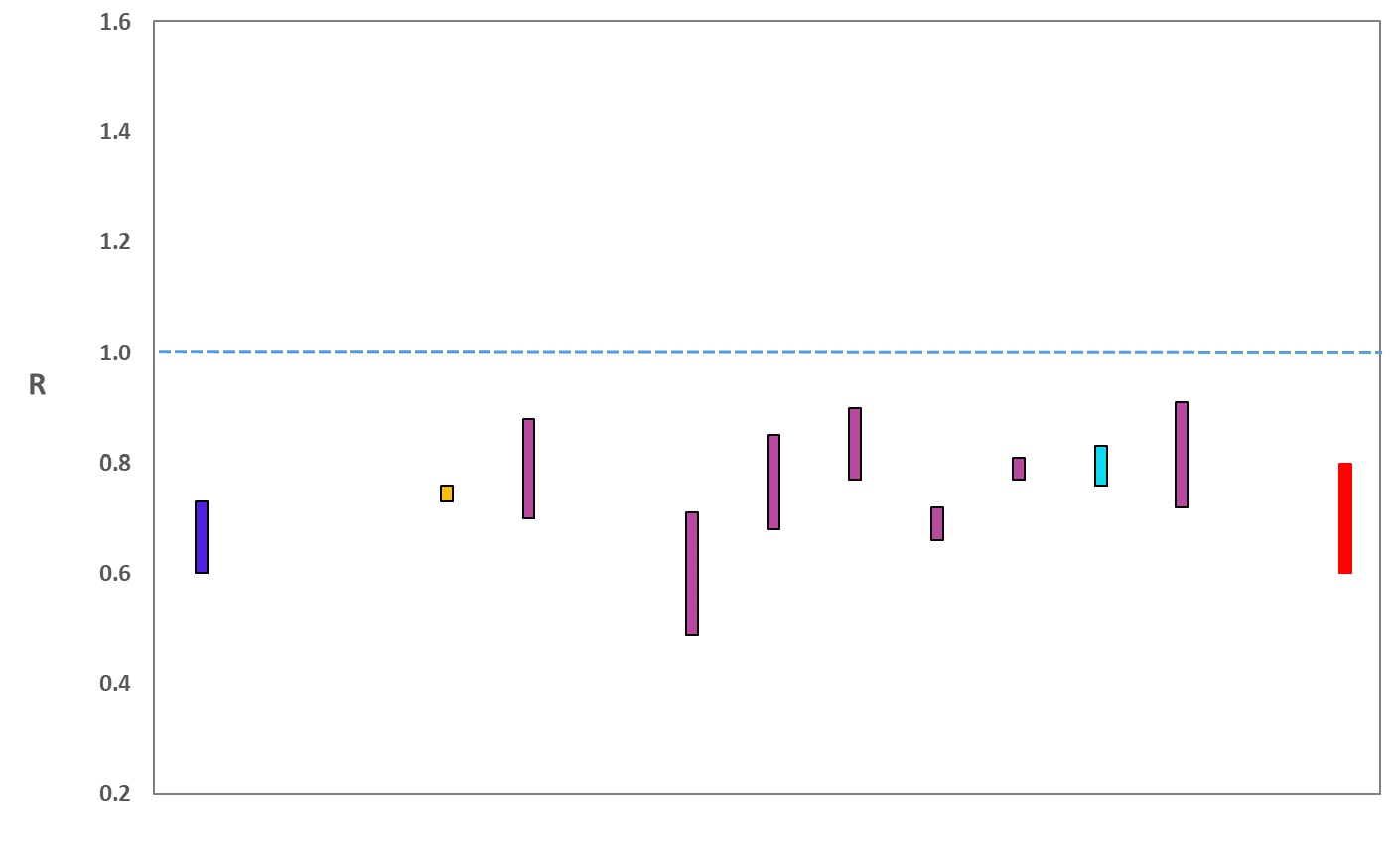
Source: Scientific Advisory Group for Emergencies (SAGE).
The various groups which report to the Scientific Pandemic Influenza Group on Modelling (SPI-M) use different sources of data in their models to produce estimates of incidence (Figure 2). The Scottish Government results this week have been computed using a platform called Epidemia (see Technical Annex in issue 37), which expands the Bayesian semi-mechanistic model which the Scottish Government runs. SPI-M's consensus view across these methods, as of 10 March, was that the incidence of new daily infections in Scotland was between 10 and 19 new infections per 100,000. This equates to between 500 and 1,000 people becoming infected each day in Scotland.
Figure 2. Estimates of incidence for Scotland, as of 10 March, including 90% confidence intervals, produced by SPI-M. The blue bar is a death-based model and the purple bars represent models which use multiple sources of data. The estimate produced by the Scottish Government (a semi-mechanistic model) is the 2nd from left (yellow), while the SAGE consensus range is the right-most (red).
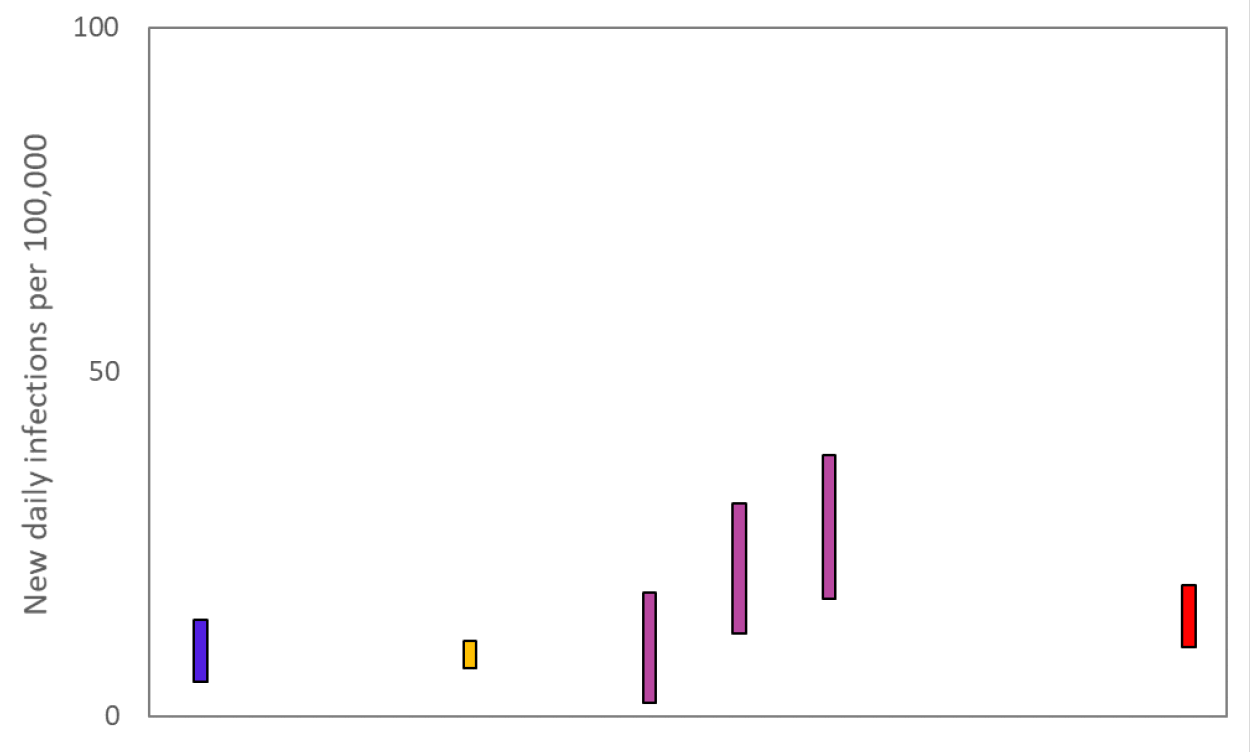
Source: Scientific Pandemic Influenza Group on Modelling (SPI-M).
The consensus from SAGE for this week is that the growth rate in Scotland is between -6 and -4% per day. On 3 March the growth rate was between -6 and -2%.
What we know about how people's contact patterns have changed
As a whole, average contacts remain steady from the last two weeks, with a current level of 3.0 daily contacts as seen in Figure 3. Contacts within the school setting have increased from the levels two weeks prior but still remain at low levels. Contacts within all other settings remain at similar levels over the same period.
Figure 4 shows how contacts change across age group and setting. Those aged between 40 and 50 have shown a large increase in contacts in the most recent survey, largely due to a rise in contacts within the work setting.
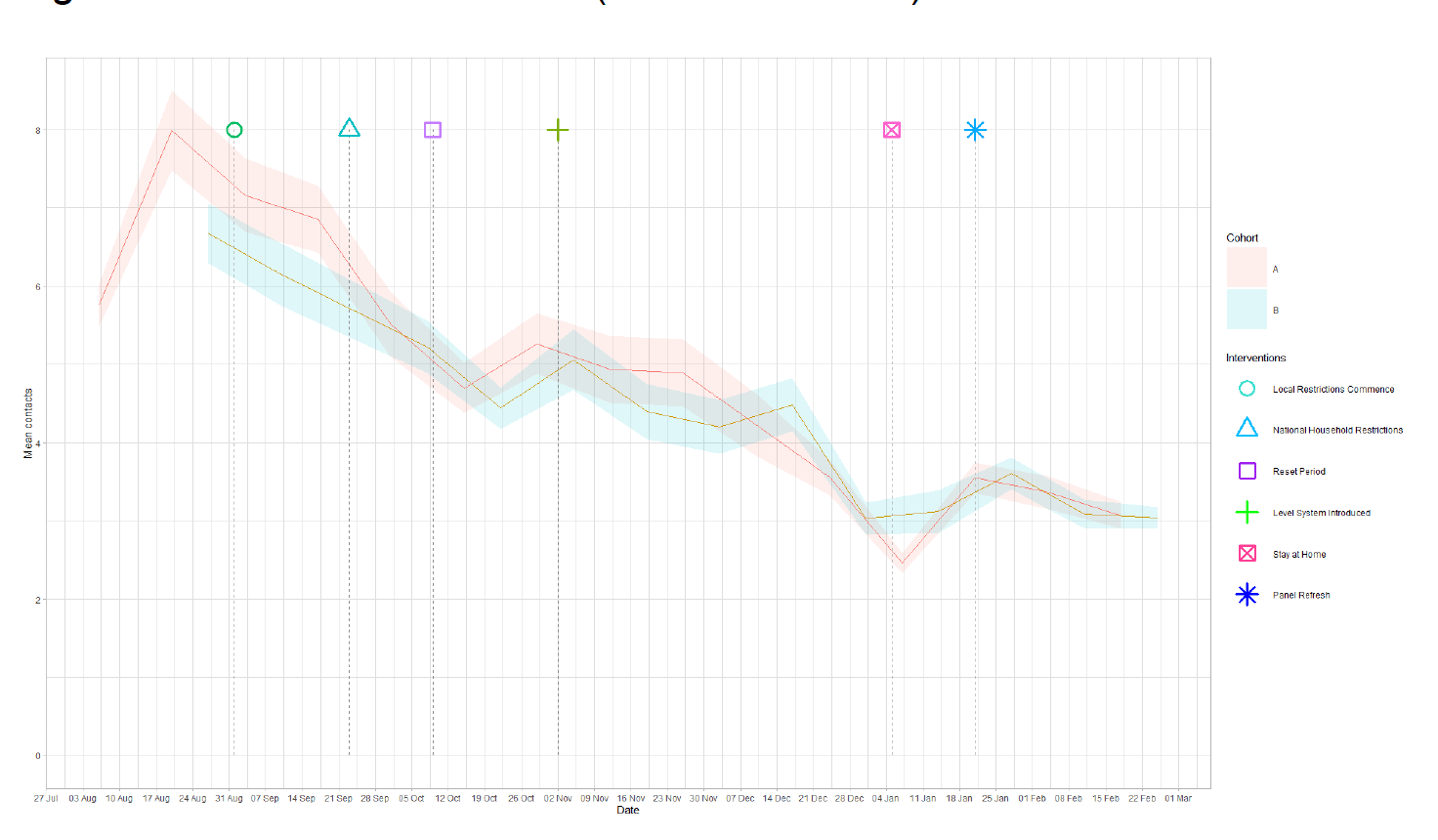
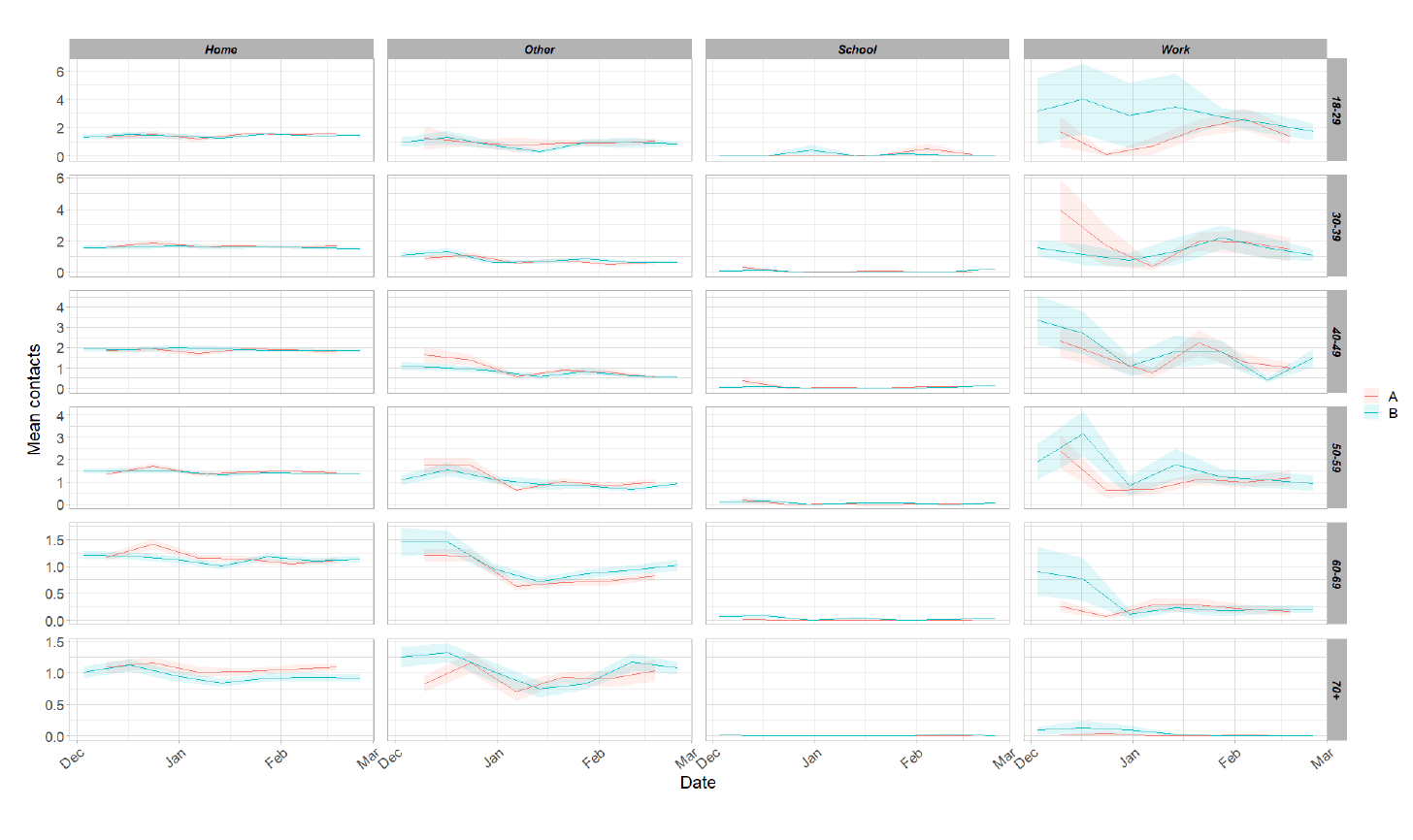
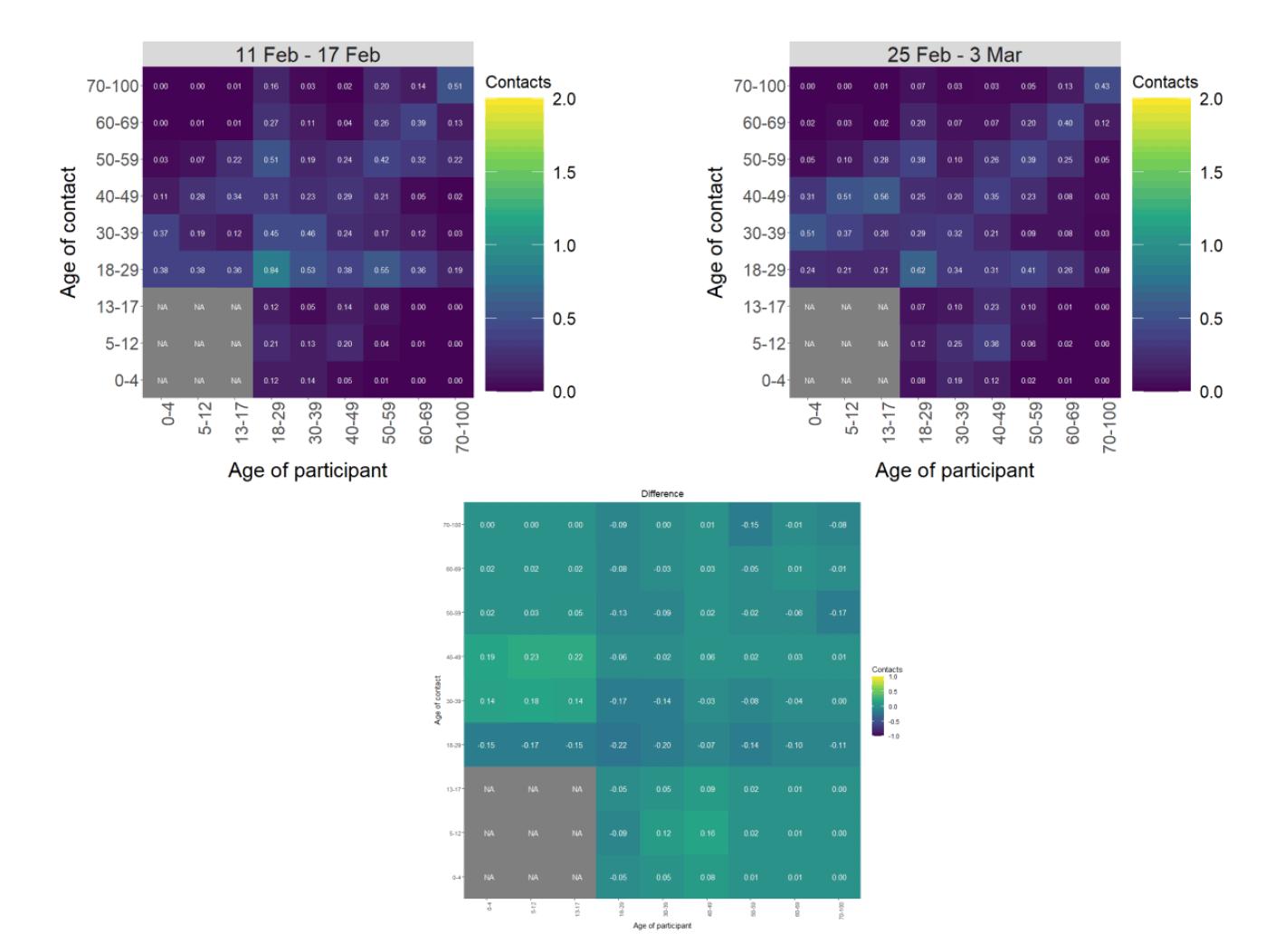
The heatmaps in Figure 5 show the mean overall contacts between age groups for the weeks pertaining to 11 – 17 February and 25February – 3 March and the difference between these interactions. In the last two weeks, the largest increase in interactions is seen between those aged 30 – 50 with those under the age of 18 which coincides with the recent return of schools (primary 1-3 returning on 22 February).
As Figure 6 shows, the biggest increase in locations that participants have visited is seen for those visiting essential shops, increasing from 73% to 78%. This is followed by individuals who visited another's home up from 20% to 24% over the same period.
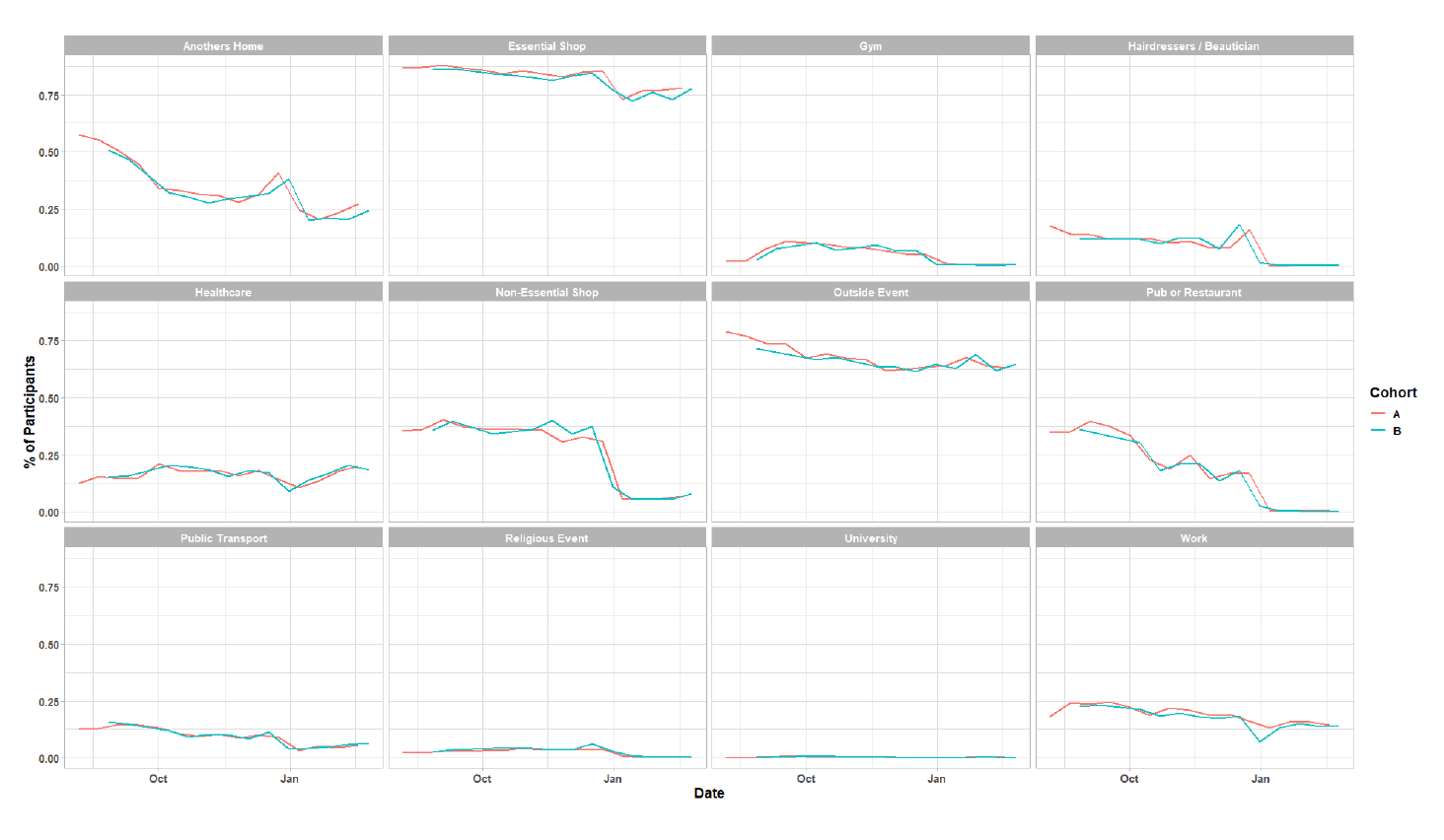
Vaccinations and contacts patterns
The vaccinations programme commenced in Scotland from December 2020. Currently vaccinations have been rolled out to individuals over 65 and higher priority groups[1]. As time progresses, a greater proportion of the population will be vaccinated[2]. This section looks at the contact patterns of those who have been vaccinated against those who have not.
In the most recent survey, 73% of participants who are health and social care workers have had the vaccine. Those vaccinated within this employment category have double the number of contacts compared to those who haven't. A significant difference is seen in the work setting contacts for this group, as opposed to the home and other settings (Table 1 in the technical annex). Although there is a clear difference between the groups, due to the absence of historical vaccine data, it cannot be said with absolute certainty that vaccination is the cause for this difference.
Due to the high number of vaccinations for those aged 65 and over (greater than 95% of the population[3]) no statistically significant comparison of the vaccinated against unvaccinated can be made for this group. Instead the contact behaviour of individuals can be looked at pre and post vaccination.
For 226 participants who reported being vaccinated with the Scottish Contact Survey, there was no change in the number of contacts seen before and after vaccination for this subgroup (Table 2 in the technical annex). It should be noted that, as many participants have only just recently been vaccinated, this is based on only two observations for each individual.
What the modelling tells us about estimated infections as well as Hospital and ICU bed demand
Scottish Government assess the impact of Covid on the NHS in the next few weeks in terms of estimated number of infections. For more on how we do this see page 4 of Issue 1 of the Research Findings[4]. Figure 7 shows two projections which take account of compliance and behaviour (better and worse[5]).
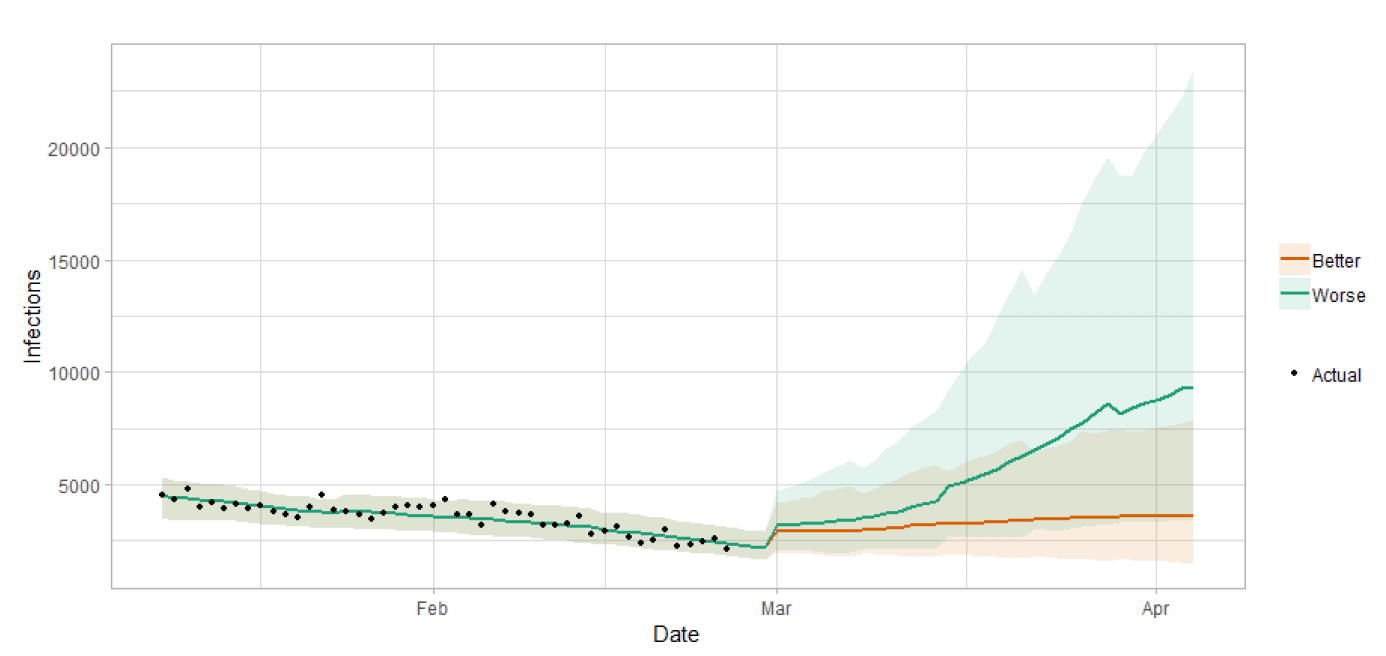
Figure 8 shows the impact of the projections on the number of people in hospital.
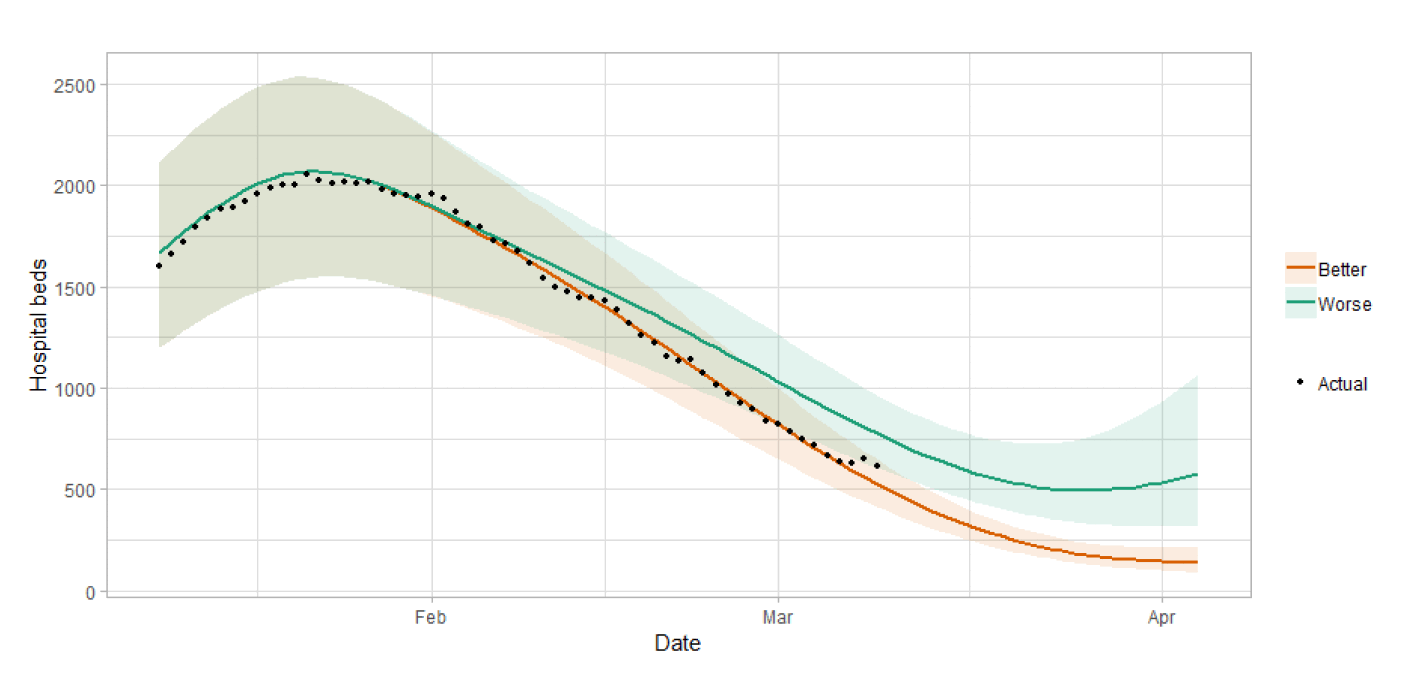
Figure 9 shows the impact of the projection on ICU bed demand.
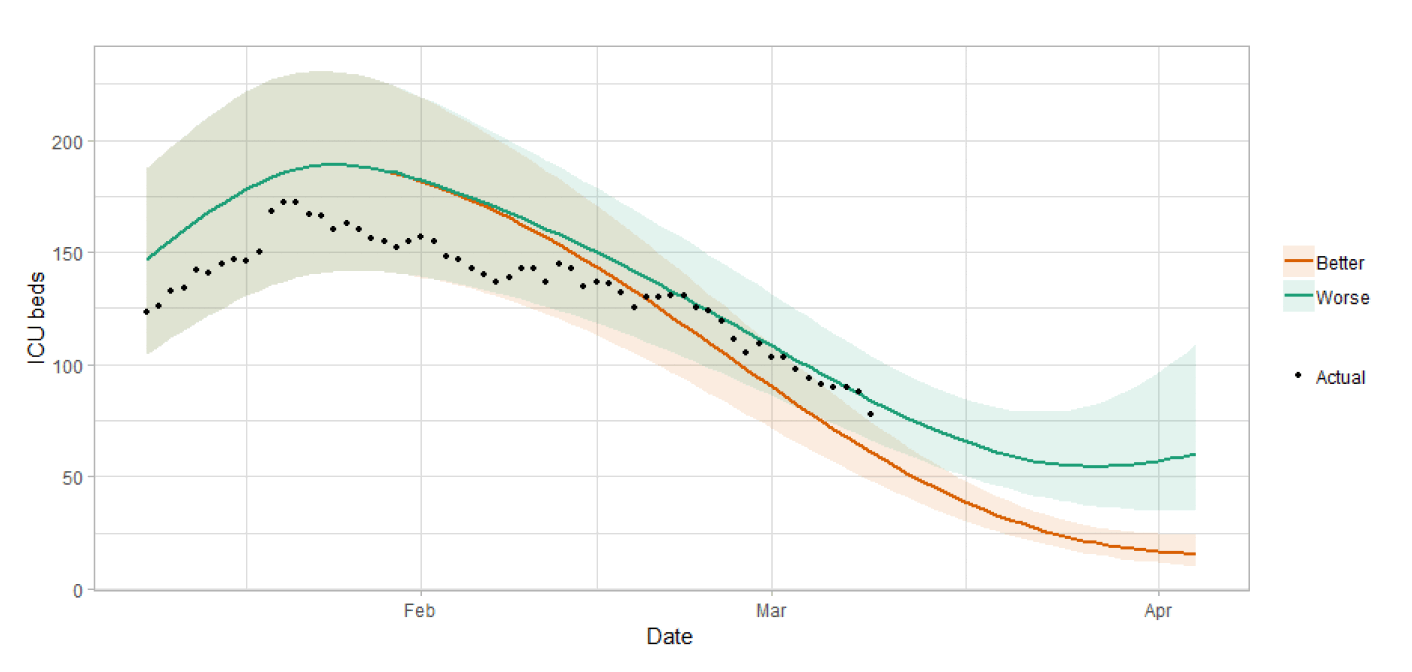
A comparison of the actual data against historical projections is included in the Technical Annex.
What the modelling tells us about projections of hospitalisations and deaths in the medium term
SAGE produce projections of the epidemic[9] (Figures 10 and 11), combining estimates from several independent models (including the Scottish Government's logistics modelling, as shown in figures 7, 8 and 9). These projections are not forecasts or predictions. They represent a scenario in which the trajectory of the epidemic continues to follow the trends that were seen in the data up to 8th March.
Modelling groups have used data from contact surveys, previous findings and their own expert judgement to incorporate the impact of re-opening schools. The projections do not include the effects of any other future policy or behavioural changes.
The delay between infection, developing symptoms, the need for hospital care, and death means they will not fully reflect the impact of behaviour changes in the two to three weeks prior to 8 March.
These projections include the potential impact of vaccinations over the next four weeks. Modelling groups have used their expert judgement and evidence from the JCVI, Public Health England, Scottish universities and Public Health Scotland as well as other published sources when making assumptions about vaccine effectiveness[10].
Beyond two weeks, the projections become more uncertain with greater variability between individual models. This reflects the large differences that can result from fitting models to different data streams, and the influence of small deviations in estimated growth rates and current incidence.
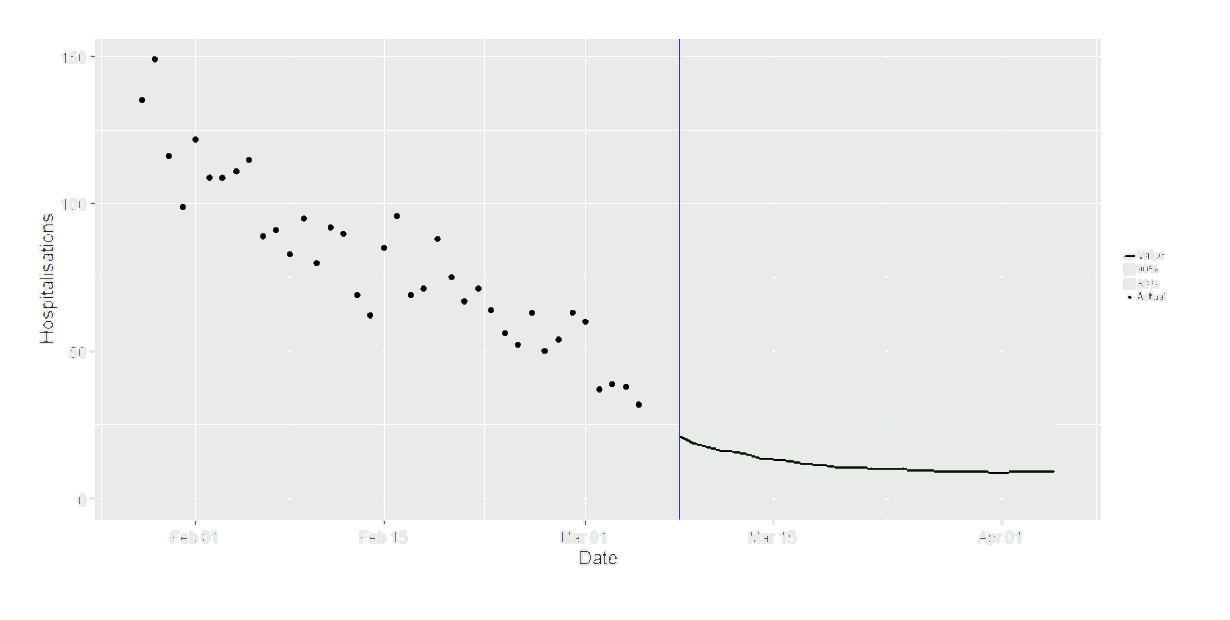
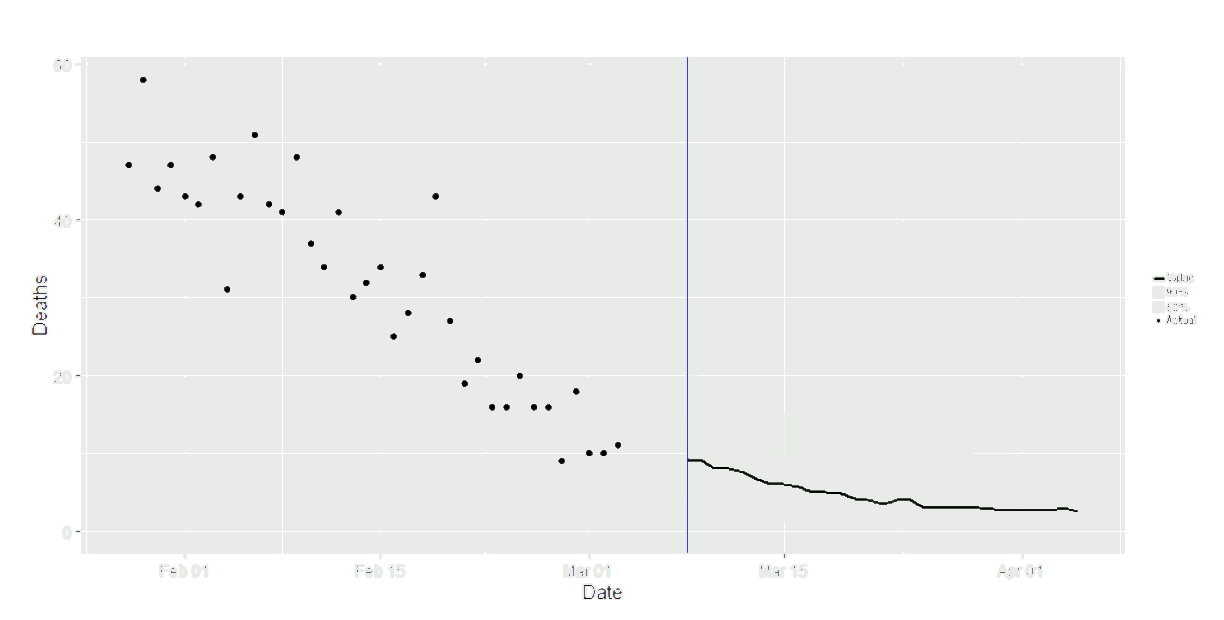
What we know about which local authorities are likely to experience high levels of Covid
We are using modelling based on Covid cases and deaths from several academic groups to give us an indication of whether a local authority is likely to experience high levels of Covid in the future. This has been compiled via SPI-M into a consensus. In this an area is defined as a hotspot if the two week prediction of cases (positive tests) per 100K population are predicted to exceed a threshold, e.g. 500 cases.
Modelled rates per 100K (Figure 12) indicate that by the week 21 – 27 March 2021, 4 local authorities have a 50-75% probability of exceeding 50 cases but no local authorities have 75% or higher probability of exceeding 50 cases. This is down from last week, when 7 local authorities had a 50-75% probability of exceeding 50 cases and 8 local authorities had a 75% or higher probability of exceeding 50 cases. The probability of exceeding will be affected by the lockdown as well as by how much new variant is present in a local authority area.
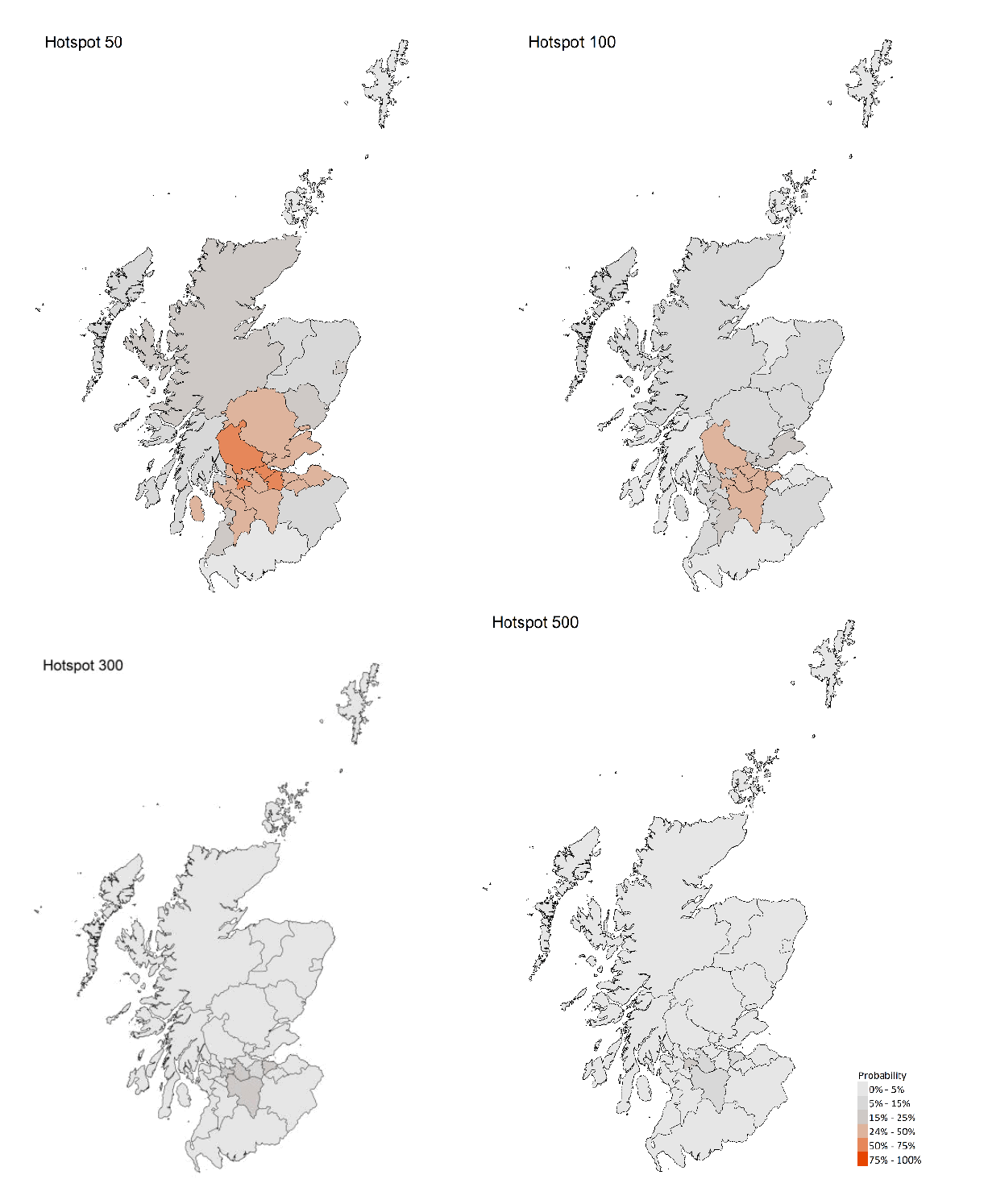
What can analysis of wastewater samples tell us about local outbreaks of Covid-19 infection?
Levels of Covid in wastewater collected at 28 sites around Scotland are adjusted for population and local changes in intake flow rate and compared to daily 7-day average positive case rates derived from Local Authority and Neighbourhood (Intermediate Zone) level aggregate data. See Technical Annex in Issue 34 of these Research Findings for the methodology.
The overall level of wastewater Covid this week showed a continued decline, corresponding well to the fall in cases and putting wastewater Covid levels as the lowest they have been since the start of October 2020. Many sites now show low levels of Covid, though some larger sites remain at moderate levels.
Figure 13 shows wastewater Covid data aggregated over sites to produce a national average time series, with new cases data overlaid. Note that compared to previous reports, the start and endpoints of weeks for the weekly wastewater averages have been shifted by a few days to avoid weeks of data with only partial reporting across sites. This causes a slight change in how the graph depicts historical data. Regardless, the single unfilled point in middle of February denotes the average for that week after the removal of an anomalously high reading at Seafield (Edinburgh). The two weeks of data subsequent to that spike shows a continued decline, with a decrease of 15% over the last week.
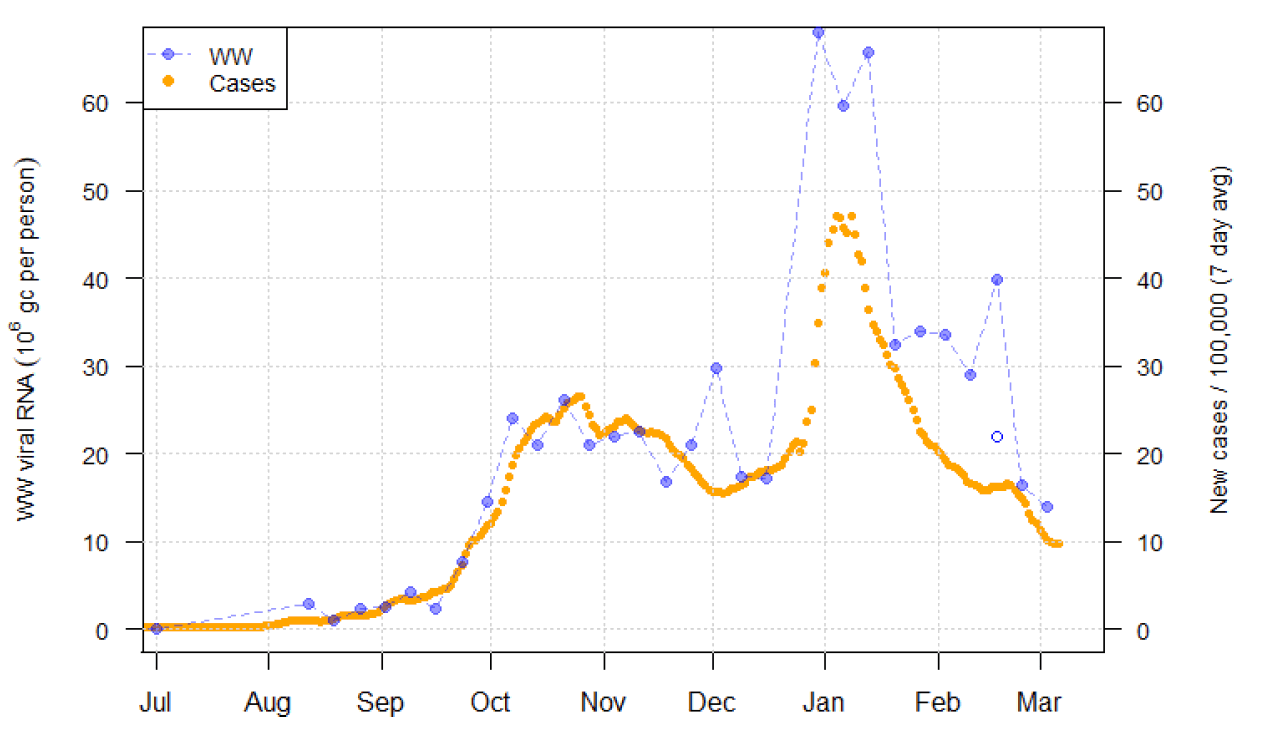
While levels overall are in decline, the message is not the same across all sites. Figure 14 examines the levels at Shieldhall in Glasgow. Here, wastewater and case rates have both remained approximately constant over the last few weeks, and although the values are low relative to higher values experienced in the recent past, they are approximately double that of the average for Scotland. A similar levelling off is also seen in Seafield in Edinburgh, though levels there are lower, with wastewater Covid at approximately 15 million gene copies/person and daily case rates of 5-10 cases/100,000. These large catchments mask the stronger decline seen elsewhere in the national picture.
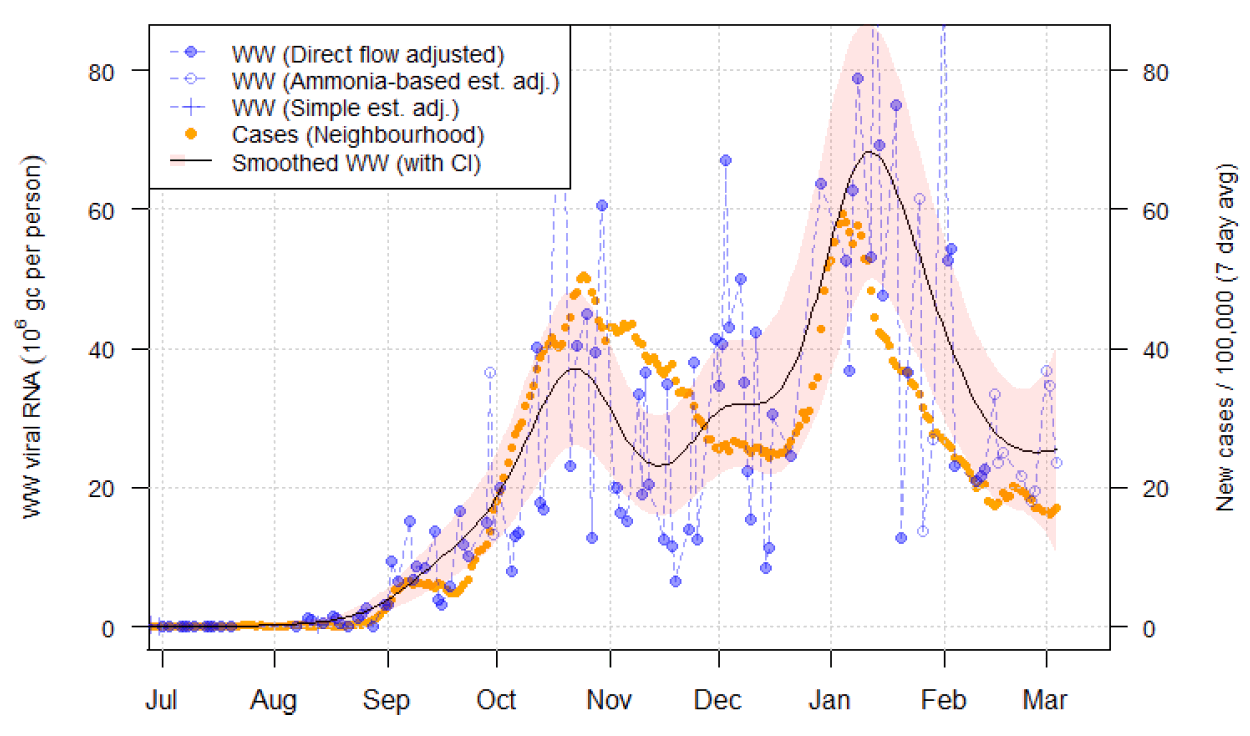
For sites with low levels of wastewater Covid and cases, in the future it may be reasonable to switch from using wastewater to estimate prevalence, to using it to ascertain the presence or absence of cases. For example, in Fort William (Figure 15), case levels have been below the level of censoring for long periods. However, recently, a level of wastewater Covid above the limit of detection has been recorded. While the correspondence of wastewater Covid to cases at this site is historically poor, and it would not be advisable to use the recent measurement to directly infer the level of prevalence, the presence of positive wastewater Covid readings nevertheless suggests the presence of infection in the region, if not the town itself. It has been suggested in the past that the presence of a hospital within the Fort William catchment explains both the large rises in wastewater Covid and why this is not replicated in case numbers.
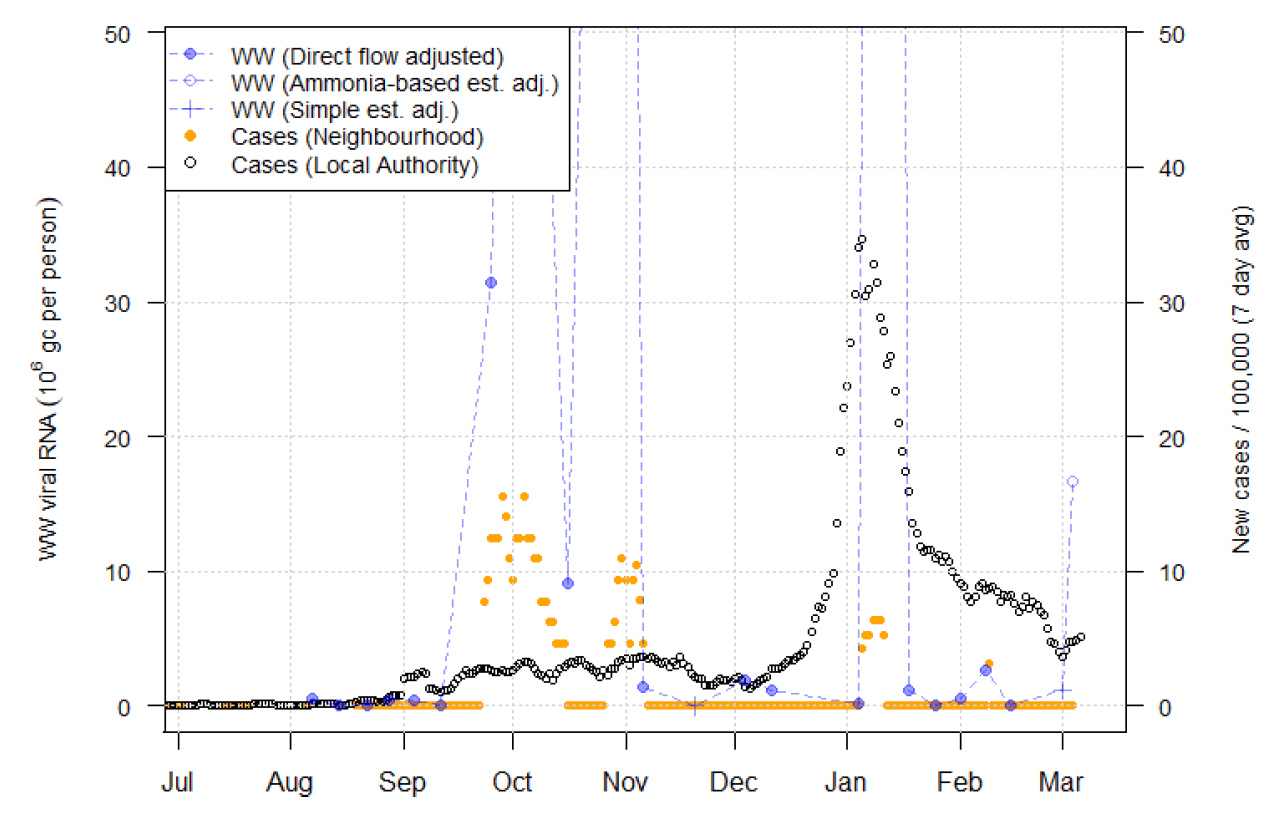
Mapping the geographic pattern of Covid-19 across the sites in Figure 16 indicates the low level of Covid-19 across many sites across Scotland. Note the large levels of wastewater Covid in Helensburgh in Argyll and Bute, as mentioned in the previous report. An additional measurement at that site has been made since the last report, still showing continued high levels of wastewater Covid.
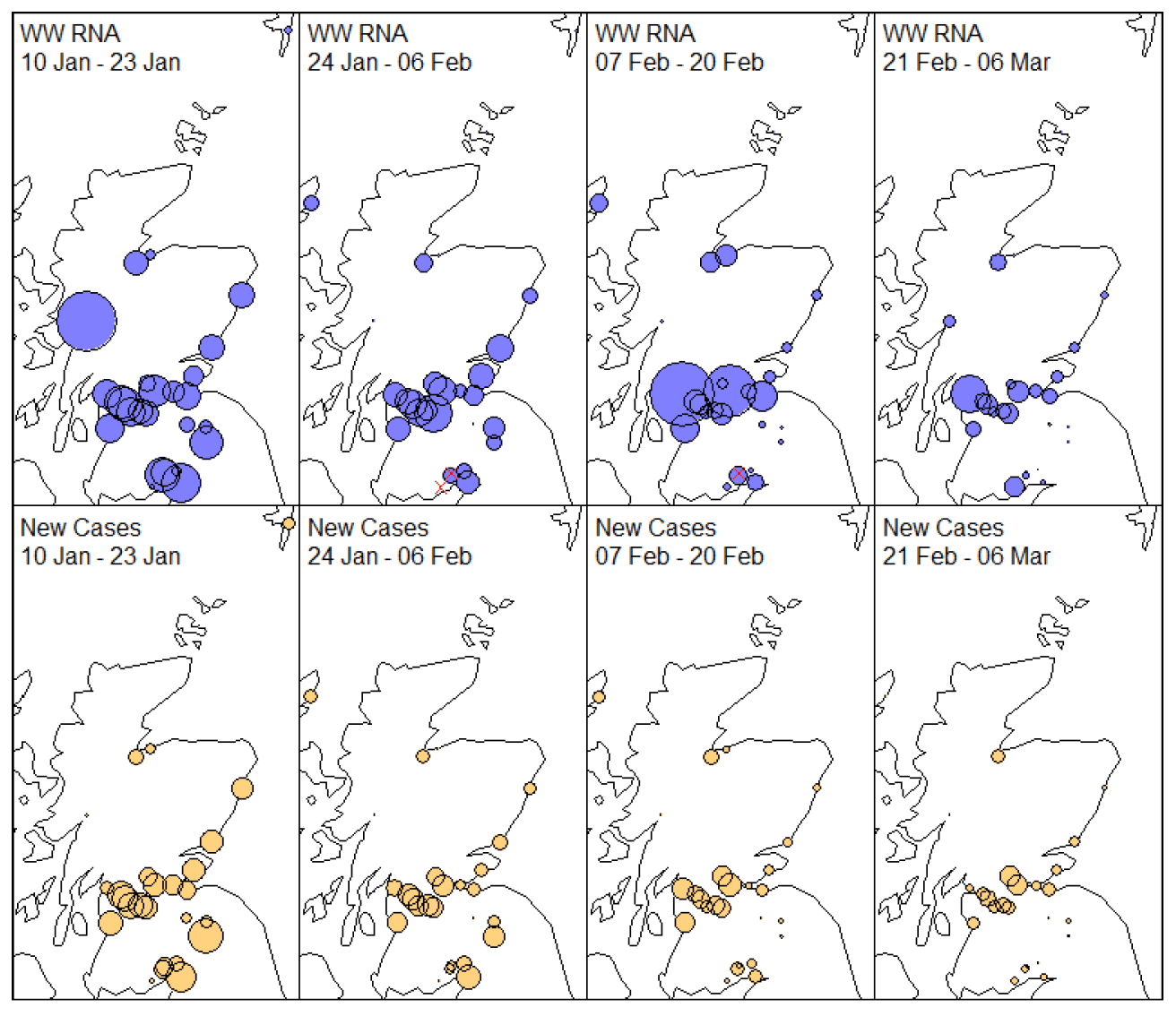
What next?
The Scottish Government continues to work with a number of academic modelling groups to develop other estimates of the epidemic in Scotland.
The modelled estimates of the numbers of new cases and infectious people will continue to be provided as measures of the epidemic as a whole, along with measures of the current point in the epidemic such as Rt and the growth rate. Further information can be found at https://www.gov.scot/coronavirus-covid-19.
Investigations are ongoing by NERVTAG, SPI-M, SAGE and Scottish Government regarding the impact of the new variant, SARS-CoV-2 VOC 202012/01, which will be reflected here as work is undertaken.
Analysis from the EAVE 2 group, which tells us about the pattern of demographics and clinical risk groups over time for those who are testing positive with Covid, will be provided in future issues.
Contact
There is a problem
Thanks for your feedback